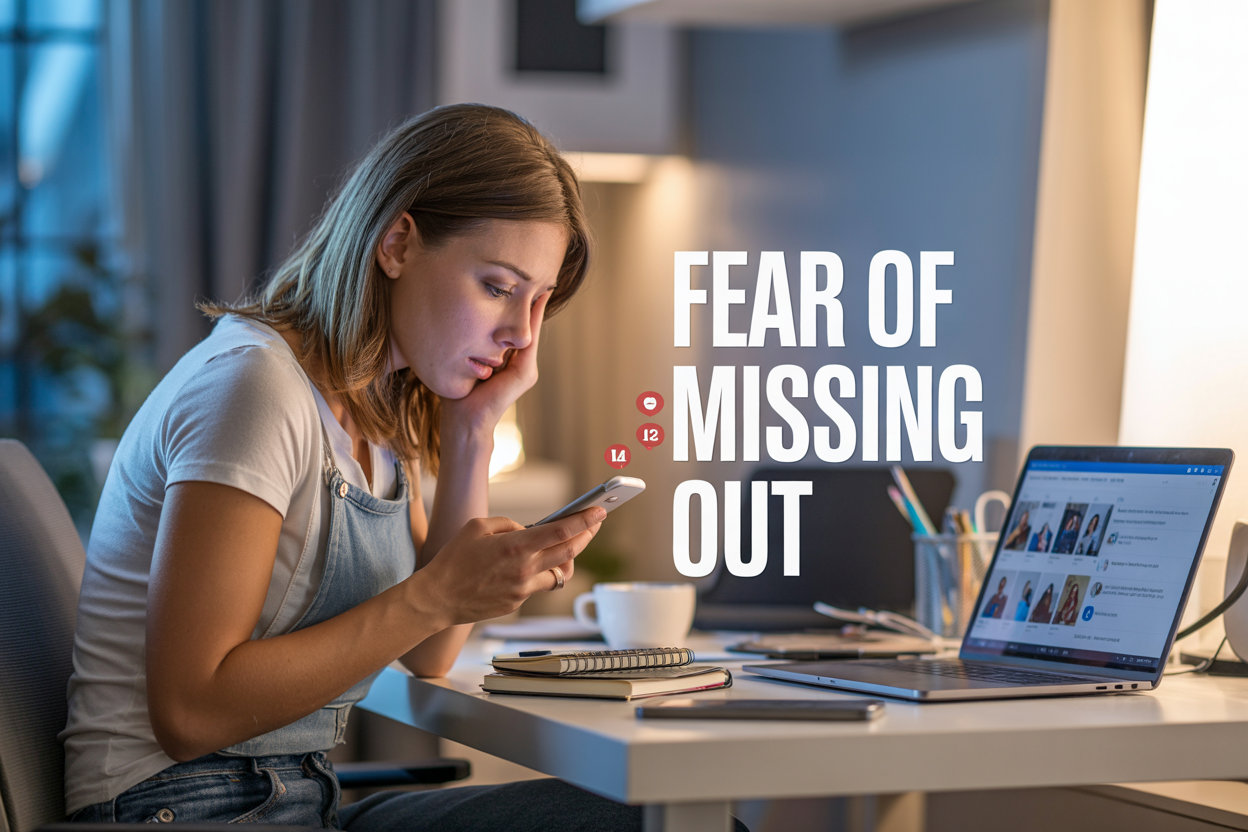Fear of Missing Out: Understanding the Psychology Behind FOMO
You check Instagram one more time before bed. Your friend posts photos from that party you couldn’t attend, and suddenly you feel anxious, restless, and like you made the wrong choice staying home. Sound familiar? You’re experiencing FOMO psychology – that nagging worry that others are having better experiences without you.
This guide is for anyone who feels constantly pulled to check social media, struggles with decision-making due to fear of missing out, or finds themselves saying “yes” to everything to avoid that uncomfortable feeling of being left behind. Whether you’re a busy professional, student, or parent juggling multiple commitments, understanding the fear of missing out definition and its psychological roots can help you regain control.
We’ll explore the psychological triggers that create FOMO and examine how social media amplifies these feelings in our daily lives. You’ll also discover practical strategies for managing fear of missing out, including how to identify your personal FOMO triggers and develop healthier relationships with social platforms. By the end, you’ll have concrete tools to overcome FOMO and make choices that align with your actual values rather than your anxieties.
Defining FOMO and Its Core Characteristics

What FOMO Really Means in Modern Context
FOMO psychology goes far beyond simple social anxiety or wanting to be included in activities. At its core, the fear of missing out definition encompasses a persistent worry that others are having more rewarding experiences, making better choices, or accessing opportunities that remain out of your reach. This phenomenon has evolved dramatically in our hyperconnected world, where social media feeds provide constant glimpses into curated versions of other people’s lives.
The modern understanding of FOMO centers on three key components: comparison, scarcity, and regret avoidance. When you scroll through Instagram and see friends at concerts, exotic vacations, or career milestones, your brain automatically begins comparing your current situation to theirs. This comparison triggers feelings of inadequacy and the belief that you’re somehow falling behind in life’s race.
FOMO also thrives on perceived scarcity. Limited-time offers, exclusive events, and “last chance” opportunities create urgency that bypasses rational decision-making. Your brain interprets these situations as potential losses rather than neutral choices, activating the same stress responses our ancestors used when facing genuine threats.
The regret avoidance aspect means you often make decisions based on avoiding future disappointment rather than pursuing genuine interests. This leads to overcommitting to social events, impulsive purchases, or career moves that don’t align with your actual values or goals.
Key Symptoms That Signal FOMO Behavior
Recognizing FOMO behavior starts with understanding its physical, emotional, and behavioral manifestations. The symptoms often overlap with anxiety disorders but have distinct characteristics tied to social comparison and opportunity costs.
Physical symptoms include restlessness when away from your phone, racing heartbeat when seeing others’ social media posts, and difficulty concentrating on present activities because your mind wanders to what else might be happening. Many people report feeling physically exhausted after spending time on social platforms, even when they haven’t been physically active.
Emotional indicators manifest as persistent dissatisfaction with your current circumstances, envy toward others’ experiences, and a nagging sense that your life lacks excitement or meaning. You might feel anxious when declining invitations, even for events you don’t genuinely want to attend. Mood swings often correspond with social media usage patterns, where your emotional state depends heavily on what you see in your feeds.
Behavioral patterns reveal themselves through compulsive social media checking, saying yes to invitations out of obligation rather than interest, and making purchases or commitments based on what others are doing rather than personal preferences. You might find yourself constantly documenting experiences for social media rather than fully engaging with them, or feeling unable to enjoy activities unless they’re shareable online.
The most telling symptom is decision paralysis when faced with multiple options, driven by the fear that any choice means missing out on potentially better alternatives. This creates a cycle where indecision itself becomes another source of anxiety and regret.
How FOMO Differs from Normal Social Anxiety
While FOMO and social anxiety share some common ground, they represent distinct psychological experiences with different triggers and manifestations. Understanding these differences helps identify which strategies will be most effective for managing your specific challenges.
Social anxiety primarily focuses on fear of judgment, embarrassment, or negative evaluation by others. People with social anxiety often avoid social situations because they worry about making mistakes, being rejected, or appearing awkward. The anxiety centers on their own performance and how others perceive them.
FOMO, conversely, stems from fear of missing positive experiences rather than avoiding negative judgment. FOMO drives you toward social situations, events, and opportunities, while social anxiety pushes you away from them. Someone experiencing FOMO might attend parties they don’t enjoy simply because they fear missing something exciting, whereas someone with social anxiety might skip the same party to avoid potential embarrassment.
| Aspect | FOMO | Social Anxiety |
|---|---|---|
| Primary Fear | Missing rewarding experiences | Being judged or embarrassed |
| Behavioral Response | Overcommitment to activities | Avoidance of social situations |
| Focus | Others’ experiences and opportunities | Personal performance and perception |
| Social Media Impact | Increases desire to participate | May increase avoidance behaviors |
| Decision Making | Fear of choosing wrong option | Fear of making any choice that draws attention |
The overlap occurs when both conditions exist simultaneously. You might experience social anxiety about attending events while simultaneously fearing you’ll miss out if you don’t go. This creates internal conflict between approach and avoidance motivations, often resulting in last-minute cancellations, showing up but not fully participating, or attending events while feeling miserable throughout.
FOMO also tends to be more situational and context-dependent than generalized social anxiety. Your FOMO might spike during certain seasons, life transitions, or when exposed to specific types of social media content, while social anxiety typically presents more consistently across various social contexts.
The Psychological Roots of FOMO

Evolutionary Origins of Social Belonging Needs
Humans are hardwired for connection. Our ancestors survived by staying close to their tribes – being excluded meant facing predators alone, struggling to find food, and ultimately facing death. This deep-seated need for social acceptance lives on in our modern brains, making us hypersensitive to signs that we might be left out.
When you feel that familiar pang of FOMO psychology, you’re experiencing an ancient alarm system that once kept your great-great-ancestors alive. Your brain doesn’t distinguish between missing a mammoth hunt and missing a friend’s party – both trigger the same primal fear of social exclusion. This explains why even minor social rejections can feel disproportionately painful and why we constantly scan for threats to our social standing.
The amygdala, your brain’s alarm center, remains on high alert for any signs of social rejection. This evolutionary wiring makes us naturally prone to comparison and the fear that others are experiencing something better, more fulfilling, or more socially valuable than we are.
Brain Chemistry Behind Comparison and Reward Seeking
Your brain treats social rewards like addictive substances. When you see others having fun without you, dopamine levels drop, creating an uncomfortable void that demands filling. This neurochemical response drives the compulsive checking behaviors associated with FOMO.
The reward system in your brain craves novelty and positive social feedback. Each notification, each glimpse of someone else’s highlight reel, triggers a small dopamine release followed by a crash. This creates a cycle where you need increasingly frequent social stimulation to maintain baseline happiness levels.
Brain areas activated during FOMO episodes:
- Anterior Cingulate Cortex: Processes social pain as physical pain
- Prefrontal Cortex: Struggles with rational decision-making during emotional flooding
- Striatum: Drives reward-seeking behaviors and comparison tendencies
- Insula: Amplifies emotional intensity of missing out experiences
Research shows that people experiencing FOMO display similar brain activity patterns to those dealing with addiction withdrawal. The constant comparison cycle literally rewires neural pathways, making it harder to find contentment in present moments.
Attachment Styles That Increase FOMO Vulnerability
Your early relationships shape how you navigate adult social situations. People with anxious attachment styles are particularly susceptible to intense FOMO experiences because their nervous systems are calibrated to expect inconsistent love and attention.
Anxiously attached individuals often:
- Seek constant reassurance from others
- Interpret neutral social cues as rejection
- Feel compelled to maintain multiple social connections simultaneously
- Experience physical anxiety when excluded from group activities
Avoidantly attached people might seem immune to FOMO, but they often experience it differently – as a fear of commitment or missing out on independence. They may hop between opportunities without ever fully engaging.
Disorganized attachment creates the most chaotic FOMO patterns, where people simultaneously crave connection and fear it, leading to self-sabotaging behaviors around social opportunities.
Secure attachment provides the best defense against problematic FOMO because these individuals have internalized the belief that they’re worthy of love and that relationships can survive temporary separations.
The Role of Low Self-Esteem in Amplifying FOMO
Low self-esteem acts like a magnifying glass for FOMO experiences. When you don’t feel inherently valuable, every social opportunity becomes a chance to prove your worth – and every missed opportunity feels like evidence of your inadequacy.
People with fragile self-esteem often:
- Catastrophize missing social events
- Believe others are having more fun because they’re more deserving
- Use social activities as external validation rather than genuine enjoyment
- Feel personally rejected when not included in every gathering
This creates a vicious cycle where FOMO behaviors (constantly checking social media, overcommitting to events, saying yes when you mean no) actually erode self-esteem further by preventing authentic self-connection and boundary-setting.
The psychology behind FOMO becomes particularly intense when self-worth depends entirely on external validation. Without a solid internal foundation, every social comparison becomes a referendum on personal value, making it nearly impossible to find contentment in solitary moments or current circumstances.
Breaking free from this pattern requires rebuilding self-worth from internal sources rather than constantly seeking proof of value through social inclusion and external achievements.
Social Media’s Role in Fueling FOMO

How Curated Content Creates False Reality Perceptions
Social media platforms present a highly polished version of reality that distorts our understanding of how others actually live. When scrolling through Instagram or Facebook, we see vacation highlights, career achievements, perfect meals, and flawless selfies. What we don’t see are the mundane moments, struggles, failures, and ordinary days that make up the majority of everyone’s life.
This curated content creates what researchers call “compare and despair” syndrome. People naturally compare their behind-the-scenes reality with everyone else’s highlight reel, leading to feelings of inadequacy and the fear that everyone else is living a more exciting, successful, or fulfilling life. The psychology behind FOMO intensifies when we believe these carefully selected moments represent someone’s entire existence.
The problem becomes worse because people tend to share their best moments more frequently than their challenges. A study by the University of Pennsylvania found that heavy social media users consistently overestimated how happy others were compared to themselves. This distorted perception fuels social media FOMO effects by making users feel they’re constantly missing out on experiences, opportunities, or happiness that others seem to enjoy effortlessly.
The Addiction Cycle of Constant Status Checking
The compulsive need to check social media feeds creates a behavioral loop that strengthens FOMO psychology. Each time we open an app, our brain releases small amounts of dopamine in anticipation of finding something interesting, exciting, or validating. This neurochemical response mirrors addiction patterns found in gambling and substance use.
The cycle works like this:
- Trigger: Feeling anxious, bored, or disconnected
- Routine: Opening social media apps to check updates
- Reward: Brief satisfaction from new content or notifications
- Reinforcement: The temporary relief encourages repeated checking
This pattern becomes particularly problematic because the rewards are intermittent and unpredictable. Sometimes we find engaging content, sometimes we don’t. This variable reward schedule is one of the most powerful reinforcement mechanisms in behavioral psychology, making the habit extremely difficult to break.
Research shows the average person checks their phone 96 times per day, with social media apps accounting for a significant portion of these interactions. Each check represents a potential trigger for FOMO, as users scan for evidence of activities, events, or experiences they might be missing.
Algorithm Design That Exploits FOMO Tendencies
Social media companies deliberately design their algorithms to maximize user engagement by exploiting psychological vulnerabilities, including our fear of missing out. These systems analyze user behavior to determine which content types generate the strongest emotional responses and keep people scrolling longest.
The algorithms prioritize content that creates urgency and emotional reactions:
| FOMO Exploitation Technique | How It Works | Psychological Impact |
|---|---|---|
| Time-sensitive content | Stories disappear after 24 hours | Creates artificial urgency to check frequently |
| FOMO-inducing notifications | “See what you missed” alerts | Triggers anxiety about missing important updates |
| Social proof indicators | “X friends are at this event” | Amplifies feelings of exclusion |
| Endless scroll design | No natural stopping point | Prevents satisfaction and closure |
Push notifications are specifically engineered to trigger FOMO and social media addiction. Phrases like “You have memories to look back on today” or “See what your friends are up to” tap directly into our fear of being left out of social connections and experiences.
The recommendation systems also create echo chambers that amplify FOMO by showing us content from people who seem to live more exciting lives than ours. If you engage with travel content, the algorithm floods your feed with more travel posts, creating the illusion that everyone you know is constantly on vacation.
These design choices aren’t accidental. Tech companies employ teams of behavioral psychologists and data scientists whose job is to make their platforms as engaging and habit-forming as possible. Understanding how to deal with FOMO requires recognizing that these platforms are specifically designed to make us feel like we’re missing out, driving us to check back more frequently and stay engaged longer.
Real-Life Impact of FOMO on Daily Living

Decision-Making Paralysis and Opportunity Overwhelm
When FOMO kicks in, making simple choices becomes surprisingly difficult. The constant worry that a better option exists just around the corner leaves people stuck in analysis loops, unable to commit to any single path. This decision fatigue shows up everywhere – from choosing restaurants to picking career moves.
Take something as basic as weekend plans. Someone dealing with FOMO might scroll through dozens of events, unable to pick one because they’re terrified another gathering might be more fun, more networking-worthy, or more Instagram-worthy. They end up either choosing nothing and staying home (then regretting it), or frantically trying to hit multiple events in one night, enjoying none of them fully.
The workplace suffers too. Professionals experiencing FOMO often struggle to focus on current projects because they’re constantly scanning for the next big opportunity, networking event, or career pivot. This scattered attention means they never dive deep enough into their current role to excel at it.
Shopping decisions become exhausting marathons of comparison. Before buying anything – from phones to furniture – the FOMO-affected person researches endlessly, reads countless reviews, and waits for sales that might never come, all while missing out on actually using and enjoying their purchases.
Financial Consequences of FOMO-Driven Purchases
FOMO psychology drives some seriously questionable spending habits. The fear of missing out on experiences, trends, or “deals” pushes people to make purchases they can’t afford or don’t actually need. Credit card debt often piles up as people chase experiences they see others enjoying online.
Limited-time offers become irresistible, even when the purchase doesn’t align with personal values or budgets. Flash sales, exclusive memberships, and “last chance” promotions tap directly into FOMO triggers, making rational financial planning nearly impossible.
Travel represents one of the biggest FOMO spending traps. Seeing friends’ vacation photos creates pressure to book similar trips, often using savings meant for emergencies or long-term goals. The “you only live once” mentality justifies expensive experiences that strain finances for months afterward.
Investment decisions suffer too. FOMO investors jump into hot stocks, cryptocurrency trends, or get-rich-quick schemes because they’re afraid of missing the next big thing. This reactive approach typically leads to buying high and selling low, the exact opposite of sound investment strategy.
Relationship Strain from Constant Availability Pressure
FOMO creates unrealistic expectations around availability and response times that damage real relationships. People feel pressured to respond to messages immediately, attend every social gathering, and maintain active engagement across multiple social platforms simultaneously.
Friends and partners often feel neglected when someone physically present keeps checking their phone for fear of missing something happening elsewhere. This divided attention sends the message that current company isn’t enough, creating resentment and distance in close relationships.
The pressure to document everything for social media also interrupts authentic connection. Instead of being present during conversations or shared experiences, FOMO-driven individuals focus on capturing the perfect post, missing the actual moment they’re trying to preserve.
Dating becomes particularly complicated when FOMO convinces someone that their perfect match might be just one swipe away. This mentality prevents the deep investment required for meaningful relationships to develop, leaving people in endless cycles of shallow connections.
Career and Academic Performance Effects
FOMO impact on daily life shows up strongly in professional and educational settings. Students dealing with FOMO struggle to focus on long-term academic goals because they’re constantly distracted by social activities, trends, or opportunities that seem more immediately rewarding.
Study sessions get interrupted by social media checks and event invitations. The fear of missing out on social connections while studying creates anxiety that makes learning less effective. Students often choose social activities over academic responsibilities, then stress about falling behind academically.
In professional environments, FOMO manifests as inability to say no to additional projects, meetings, or networking events. This overcommitment leads to burnout and mediocre performance across all activities rather than excellence in focused areas.
Career development suffers when professionals constantly second-guess their chosen path, wondering if they should have picked a different industry, role, or company. This grass-is-greener mentality prevents the sustained effort required to build expertise and advance meaningfully in any single direction.
The constant connectivity pressure means work-life boundaries dissolve. Employees feel compelled to check emails after hours and during weekends, afraid that missing a message might cost them opportunities or make them appear less committed than colleagues.
Recognizing Your Personal FOMO Triggers

Identifying Situations That Activate FOMO Responses
Your FOMO triggers identification starts with recognizing specific situations that make your heart race with anxiety about missing something important. Common trigger scenarios include scrolling through social media and seeing friends at events you weren’t invited to, hearing colleagues discuss exciting work opportunities you didn’t know about, or discovering a popular restaurant everyone’s talking about except you.
Travel-related content often sparks intense FOMO responses, especially when you see carefully curated vacation photos while stuck at work. Shopping situations create another layer of triggers – flash sales, limited-time offers, and exclusive deals prey on your fear of missing out on great bargains. Professional networking events, industry conferences, and career development opportunities frequently activate workplace FOMO.
Pay attention to seasonal patterns too. Holiday gatherings, summer festivals, and major life milestones like weddings or graduations can intensify these feelings. Even seemingly minor situations like choosing what to watch on Netflix or which restaurant to visit can trigger decision paralysis rooted in FOMO psychology.
Understanding Your Unique Vulnerability Patterns
Everyone experiences FOMO triggers differently based on personal values, insecurities, and life experiences. Your vulnerability patterns often connect to deeper psychological needs like belonging, achievement, or self-worth validation. Some people feel most vulnerable around career advancement opportunities, constantly worried they’re falling behind professionally. Others experience intense social FOMO, feeling excluded when friends gather without them.
Perfectionists typically struggle with decision-making FOMO, obsessing over choosing the “best” option instead of simply a good one. People with low self-esteem might be particularly sensitive to social media posts that highlight others’ seemingly perfect lives. Your upbringing also shapes these patterns – growing up in competitive environments often creates lasting FOMO around achievement and success.
Consider your personal relationship with scarcity. Do you panic when you think something might run out? This scarcity mindset amplifies FOMO responses across different life areas. Understanding these deeper patterns helps you recognize why certain situations hit harder than others.
Tracking Emotional and Physical FOMO Symptoms
FOMO manifests through both emotional and physical symptoms that serve as early warning signals. Emotional symptoms include sudden anxiety spikes, feelings of inadequacy, irritability when seeing others’ experiences, and persistent worry about making wrong choices. You might notice increased comparison behaviors, where you constantly measure your life against others’ highlight reels.
Physical symptoms of FOMO psychology include restlessness, difficulty concentrating, sleep disruption from overthinking missed opportunities, and compulsive phone checking. Your body might experience tension headaches, stomach knots, or that familiar chest tightness when encountering potential missed experiences.
Keep a simple FOMO journal for one week, noting:
| Trigger Situation | Emotional Response | Physical Symptoms | Intensity (1-10) |
|---|---|---|---|
| Friend’s vacation post | Jealousy, inadequacy | Chest tightness | 7 |
| Work opportunity missed | Anxiety, regret | Restlessness | 8 |
| Restaurant recommendation | Decision paralysis | Overthinking | 5 |
Track when these symptoms occur most frequently. Many people notice patterns tied to specific times of day, days of the week, or particular social media platforms. This tracking helps you develop personalized strategies for managing fear of missing out before it overwhelms your daily peace of mind.
Proven Strategies to Overcome FOMO

Mindfulness Techniques for Present-Moment Awareness
Breaking free from FOMO starts with training your mind to appreciate what’s happening right now. Mindfulness anchors you in the present, stopping that constant mental drift toward what others might be doing.
Start with the 5-4-3-2-1 grounding technique. Name five things you can see, four you can touch, three you can hear, two you can smell, and one you can taste. This simple exercise pulls your attention away from social media comparisons and back to your immediate environment.
Daily meditation, even just 10 minutes, builds your present-moment awareness muscle. Apps like Headspace or Calm offer guided sessions specifically designed for overcoming FOMO psychology. The key is consistency, not perfection.
Practice mindful breathing throughout your day. When you feel that familiar FOMO anxiety creeping in, take five deep breaths while focusing solely on the sensation of air entering and leaving your lungs. This interrupts the spiral of comparative thinking that fuels fear of missing out.
Body scan meditation works exceptionally well for FOMO sufferers. Starting from your toes and working up to your head, notice physical sensations without judgment. This practice strengthens your ability to stay grounded in your own experience rather than getting lost in others’ highlight reels.
Digital Detox Methods That Actually Work
Complete digital elimination rarely works long-term. Instead, create structured boundaries that reduce social media FOMO effects without making you feel completely disconnected.
Implement phone-free zones in your home. Keep bedrooms and dining areas device-free to protect sleep quality and family connections. These spaces become sanctuaries where FOMO can’t reach you.
Try the “sunset rule” – no social media after sunset. Evening hours are when FOMO hits hardest as you scroll through others’ dinner plans, parties, and social gatherings. Use this time for reading, hobbies, or face-to-face conversations instead.
Effective Digital Detox Schedule:
| Time Period | Action | Duration |
|---|---|---|
| Morning | No social media for first 2 hours | Daily |
| Afternoon | Single 30-minute check-in | Daily |
| Evening | Complete digital shutdown | 2 hours before bed |
| Weekend | One full day offline | Weekly |
Replace mindless scrolling with intentional engagement. When you do check social media, have a specific purpose – messaging a friend, checking event details, or sharing your own content. Aimless browsing feeds FOMO more than purposeful use.
Building Genuine Self-Worth Independent of Others
Your worth isn’t determined by likes, follows, or invitations. Building authentic self-esteem requires looking inward rather than outward for validation.
Start a daily accomplishment journal. Write down three things you did well each day, no matter how small. Made your bed? Helped a colleague? Tried a new recipe? These personal wins matter more than external recognition.
Develop skills that bring you joy regardless of others’ opinions. Learn guitar, practice photography, write poetry, or master cooking techniques. The satisfaction comes from personal growth, not social media posts about your progress.
Create a personal values list. What matters to you beyond social approval? Maybe it’s creativity, kindness, learning, or adventure. When decisions align with your core values rather than others’ expectations, FOMO loses its power.
Challenge negative self-talk immediately. When you catch yourself thinking “Everyone else is having more fun,” reframe it: “I’m choosing activities that align with my needs right now.” This shift from comparison to personal choice builds authentic confidence.
Creating Meaningful Life Goals Beyond Social Validation
FOMO often stems from lacking clear personal direction. When you don’t know where you’re going, everyone else’s path looks more appealing.
Set goals based on your interests, not trending activities. Want to learn Spanish because you love the culture, not because language learning looks impressive on Instagram? That’s authentic goal-setting.
Break large aspirations into smaller, private milestones. Not every achievement needs an audience. Sometimes the most meaningful progress happens quietly, away from social media’s demanding spotlight.
Goal Categories That Combat FOMO:
- Skill Development: Learning for personal satisfaction
- Relationship Building: Deepening existing connections
- Health Improvements: Physical and mental wellness
- Creative Projects: Self-expression without external validation
- Service Activities: Contributing to causes you care about
Focus on process goals rather than outcome goals. Instead of “I want to run a marathon so people think I’m athletic,” try “I want to build running endurance because I enjoy the mental clarity it brings.”
Developing Healthy Decision-Making Frameworks
Strong decision-making skills protect you from impulsive choices driven by FOMO. When you trust your judgment, others’ activities become less influential.
Use the 24-hour rule for social invitations. Don’t immediately say yes or no to events. Take a day to consider whether the activity genuinely interests you or if you’re just afraid of missing out.
Create a personal decision matrix. Rate opportunities on factors like: genuine interest, energy level, financial impact, and alignment with current goals. This systematic approach reduces emotional, FOMO-driven choices.
Practice saying no without elaborate explanations. “That sounds fun, but I can’t make it” is complete. You don’t owe anyone a detailed justification for how you spend your time.
Build a trusted advisor network – friends or family who know your values and can offer perspective when FOMO clouds your judgment. Sometimes an outside voice helps clarify whether an opportunity truly fits your life.
Remember that choosing one path means not choosing others, and that’s perfectly normal. Every yes requires saying no to something else. FOMO makes this natural trade-off feel like failure, but it’s actually healthy prioritization.

FOMO affects nearly everyone at some point, creating a constant feeling that we’re somehow falling behind or missing something important. The anxiety stems from our basic human need for connection and belonging, but social media has turned this natural instinct into an overwhelming cycle of comparison and restlessness. When we understand what triggers our FOMO and how it shows up in our daily lives, we can start taking back control instead of letting it drive our decisions.
Breaking free from FOMO doesn’t mean disconnecting from everything or everyone. It’s about being intentional with your choices and finding peace with the path you’re on. Start by identifying what specifically makes you feel like you’re missing out, then practice saying no to things that don’t truly matter to you. Remember that everyone’s highlight reel on social media isn’t the full story, and your life doesn’t need to look like anyone else’s to be meaningful and fulfilling.









